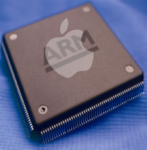I was looking at a tweet from an Apple PC user that indicated if Apple moved to ARM, something they have apparently been planning, she would abandon the platform. Given how ugly the move from PowerPC to Intel was, it would seem that this planned 2020 move by Apple would be a train wreck. And it could be, but the world has changed a lot in the last decade or so and most of the apps aren’t on the MacOS but iOS now. Microsoft has a version of Office for iOS so that takes care of basic productivity leaving only the film, photo editing, and unique MacOS apps at risk. Granted the creators/editors that use these apps are a big part of Apple’s remaining base, but the applications have shifted from using CPUs to GPUs anyway. Given enough time, and 2 years is enough (given iOS exists) to get that done.
But with Microsoft playing with ARM based Always Connected PCs as well, maybe Apple’s move won’t be a train wreck.
Moving To Arm
Apple’s PC market share hasn’t been anything to write home about hovering around 6.8%. It was up last year after dropping like a rock in 2016. They clearly need to mix something up and their iPad numbers have been dismal however their iPad Pro is beginning to show promise. However, the entire premise of a detachable which was initially missioned to stop iPads from taking out PCs has proven to be false and laptops continue to reign supreme suggesting Apple needed to make a bolder move. They needed something closer to the Surface Notebook than the original Surface, something that Microsoft clearly saw first with their own notebook and latest move to the Always Connected PC notebook designs.
In addition, Apple has strategic sales partnerships with Cisco and IBM but neither of those companies deal with consumer products anymore and really need something far closer to a notebook offering than a tablet. This has been a critical problem for both companies. IBM needed something far closer to a ThinkPad than an iPad but MacBooks, as they are, didn’t seem to be effective either largely because most app development was on iOS not MacOS, and in the Enterprise, on PCs, Windows remains supreme.
So, moving to ARM should accelerate the growth that Apple is showing with the iPad Pro. However, …
The Pain Of Transition
The issue with an X86 to ARM migration is that the X86 platform optimized performance and the ARM platform optimized on energy use. This means that ARM laptop solutions don’t have any performance headroom, so virtualization or emulation solutions tend to add too much headroom and noticeably slow performance. The positive tradeoff is massive improvements to battery life and weight but if you were to come from a current generation X86 PC and move to a current generation ARM PC you’d definitely feel a noticeable performance drop.
This means that to make up for that you’d want to make sure you had a reasonably strong GPU solution that would integrate with the ARM solution. The best vendor for that is Qualcomm but Apple is in a death match with that company making it unlikely they’ll be able to get the help they’d need from that company timely. The other choice would be to partner with AMD to create the same kind of solution and AMD is certainly willing to collaborate, but AMD currently lacks much depth in ARM even though they were one of the players with the ARM server effort several years back. They are likely the best port in this storm, but deep collaboration would be needed between the two firms to create what would be a unique solution and Apple isn’t known for doing that well.
With all migrations, there will be apps that just won’t make it. This has been a big problem for Microsoft’s own Windows S. Windows S has a number of huge advantages particularly with security, but it won’t run alternative browsers or apps like Steam and people feel they need these options so, outside of education, Windows S growth has been disappointing. Apple will have similar issues in that not all things that run on a Mac will run on iOS notebooks well, if at all.
Finally, Steve Jobs could do stuff like this and convince buyers that the pain was worth the gain. But Tim Cook doesn’t operate like this and is historically light, when compared to Jobs, when it comes to demand generation marketing. He failed to turn the Apple Watch into the hit it should have been and the HomePod isn’t exactly the hit of the year either. People don’t like change and if this change isn’t presented properly Apple could lose rather than gain share.
Wrapping Up:
Moving to ARM is a clever idea based on the sales of the iPad Pro vs. MacBooks. However, like all things, execution trumps the idea, and this isn’t Steve Jobs’ Apple. The first several years of this transition will be painful though, much like the move from PowerPC to Intel was, once this time is past Apple should be in a better place. The real problem is Apple just isn’t executing demand generation well anymore with the Apple Watch and HomePod as examples of poor execution. Regardless of the potential for this new ARM line, if Apple doesn’t execute, they’ll have to leave the PC market rather than ride the change to ever larger market share. Given this all hinges on Apple execution at a level we haven’t seen this decade, the outlook for this effort is grim unless, somehow, Apple again channels Steve Jobs.








